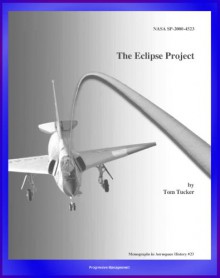The Eclipse Project (NASA SP-2000-4523) - Experiments with Unique Rocket Launch Technique Using Rope Aerotow, F-106A, QF-106A, Gordon Fullerton, Tethered Flights
This is the fascinating story of a little-known futuristic research project which investigated a concept brought to the Dryden Flight Research Center by Kelly Space. Kelly hoped to demonstrate a new approach to satellite launching by towing a rocket to altitude behind a transport airplane.The...
show more
This is the fascinating story of a little-known futuristic research project which investigated a concept brought to the Dryden Flight Research Center by Kelly Space. Kelly hoped to demonstrate a new approach to satellite launching by towing a rocket to altitude behind a transport airplane.The Eclipse Project by Tom Tucker provides a readable narrative and a number of documents that record an important flight research effort at NASA's Dryden Flight Research Center. Carried out by Kelly Space & Technology, Inc. in partnership with the Air Force and Dryden at Edwards Air Force Base in the Mojave Desert of California, this project tested and gathered data about a potential newer and less expensive way to launch satellites into space. Whether the new technology comes into actual use will depend on funding, market forces, and other factors at least partly beyond the control of the participants in the project. This is a familiar situation in the history of flight research.Frequently, the results of discoveries through flight research are not implemented immediately after projects are completed. A perfect example of this phenomenon is the lifting-body research done in the 1960s and 1970s that finally lead to new aerodynamic shapes in the world of aviation and space only in the 1990s. Even then, the lifting-body shapes (for the X-33 technology demonstrator and the X-38 prototype crew return vehicle) were only experimental. Other technologies emerging from flight research, such as movable horizontal stabilizers, supercritical wings, winglets, and digital fly-by-wire moved more rapidly into actual use in operational flight vehicles, but it was never crystal clear at the start of a flight research project whether the results would simply inform future practice or would be adopted more or less completely by air- and spacecraft designers.Regardless of the eventual outcome in the case of the Eclipse Project, it was a unique and interesting experiment that deserves to be recorded. Tom Tucker has told the story in an interesting way that should make the monograph a joy to read. I thank him for his hard work, writing skill, and his flexibility as the monograph went through the coordination process. He was busy with teaching and writing another book; yet he unfailingly responded to my requests for technical changes in the monograph as various participants refined the details of the events surrounding the tow testing of the QF-106 behind its C-141A tow vehicle.Start Up * The Elements * Names * Subsystems and Worry * Space * The Proof * Eclipse Flight Log * The Eclipse Project * Background * Eclipse Astroliner Concept * Historical Precedents * Aircraft / Weight / Wingloading / Comments * Program Philosophy * Obvious Issues * Pilot Training * EXD Pilot * Eclipse Simulation * EXD Cockpit * Attachment Hardware * C-141 Modifications * Tow Rope * Untethered Tests - C-141 Takeoff * C-141 Takeoff Profile * Tethered Research Objectives * Initial Results * Weak Link Release Procedure * Lessons Learned
show less
Format: kindle
ASIN: B008N74WDI
Publish date: 2012-07-19
Publisher: Progressive Management
Pages no: 103
Edition language: English

